Written by
06 February, 2025
Email marketing is one of the most effective business tools, but its success relies on having a clean, healthy email list. Over time, email decay is inevitable—subscribers unsubscribe, stop engaging, or change email addresses, leaving your list filled with inactive or invalid contacts. This decay leads to bounces, low engagement rates, and doubts about the effectiveness of your efforts. Neglecting it can hurt your sender reputation, diminish ROI, and reduce the impact of your campaigns.
There’s good news for you, though: with this guide, you can fix these problems and have a healthy email list in no time. Then, you can learn how to maintain it so you can connect with your prospects and get great satisfaction from those relationships.
Email hygiene refers to maintaining a clean and healthy email list. It entails using tools and due diligence to get rid of bad, obsolete email data. You achieve email hygiene through the practice of routine email scrubbing.
Email hygiene isn’t a destination you reach but an ongoing journey that requires your vigilance. Thankfully, with the right tools, you can automate a big part of the process so you can focus on the creative side.
Want to see how email scrubbing works?
Want to see how email scrubbing works?Try the ZeroBounce free email verifier
Email scrubbing, also known as email verification, is the process of identifying and removing poor-quality and risky email addresses from a list. Nix the bad emails without regret if you want your email marketing to work.
See how an email list evaluator gives you insight into the health of your email list.Learn More
It is crucial to recognize the signs of a list that is no longer in tip-top shape. This will help prevent your list from becoming dirty.
Identifying and removing bot subscriptions with email list scrubbing can be crucial for maintaining a healthy list and ensuring accurate . Look for patterns, such as rapid signups from the same IP address or region, email addresses with random strings of characters, or repetitive patterns.
Some bots also use temporary or disposable email services or are from locations that don’t align with your target demographics. Often, there’s a mismatch in the subscriber details. For example, the first names don’t match the email patterns. Bots also can give themselves away with zero or minimal opens or interactions.
If you encounter an email address (or several) that concerns you, consider using an to verify it so you can remove fake or invalid emails immediately.
The reason you clean your email list is because of what will happen if you don’t. It’s a lot like regular appointments to the doctor or the dentist. An ounce of prevention is worth a pound of cure and definitely applies to email list health.
Even a vibrant email list will degrade, which happens for a number of reasons.
It’s a fact of life that some people drop their old email address and get another one. Sometimes, it’s because they change employers or schools. Other people make it a regular habit to ditch one email address in favor of a new one.
Aside from your existing contacts degrading, you may also be acquiring new, invalid leads. Fake or bot sign-ups won’t help you improve your email marketing – on the contrary, they will only bring down your engagement rate.
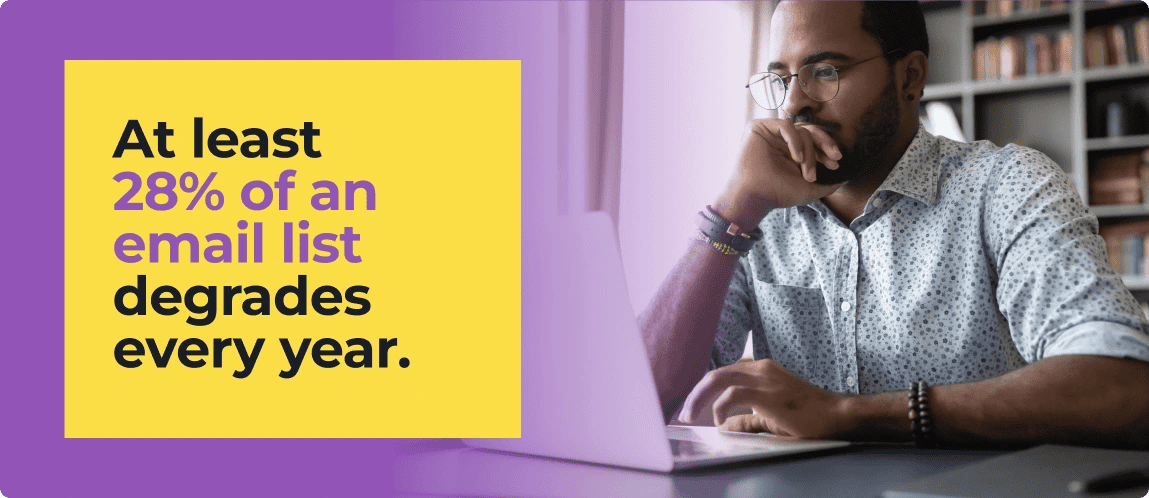
Email data decays faster than you think. After analyzing six billion emails, our team at ZeroBounce found that only were valid and non-risky. However, some lists are especially prone to swifter and steeper deterioration.
The popular email providers have a vast number of email accounts. Gmail has 1.8 billion users, more than any provider on the planet. However, Google wants to ensure users are active in their inboxes and those accounts aren’t being used for spam and phishing scams. It’s why Google is going to .
Also, maybe you saw ? The company announced that it did this to allow the recycling of usernames. In other words, if BamaBoy12321 abandoned his mailbox, that username would be up for grabs, and someone else could start using it.
These mass deletions or purges are not conducive to good email hygiene. If Yahoo removed a multitude of accounts and those obsolete contacts are on your email list, it will result in bounces.
You can counteract email service providers mass-deleting accounts by staying on top of periodic email verification. ESPs are smart to eliminate obsolete data; you can do the same through regular email list scrubbing.

After analyzing more than six billion emails, ZeroBounce found that only 57% of them were genuine and safe to keep. The email verification software detected more than 1.27B invalid contacts.
There are some things you can do to elevate your email list health. Follow these good habits below to see better results from your campaigns.
Practice regular email validationⓘ
No less than quarterly, consider running your email list through an email verifier to identify fake or inactive email addresses. That way, you avoid bounces, protect your sender reputation, and stay off email blacklists.
Try the ZeroBounce free email verifier
Try it nowCheck all new sign-ups
You wouldn’t want to clean your list and then have damaging emails seep right back into your it via your sign-up forms. Your email verification provider should also give you access to an , which is a real-time checker for all of your new email sign-ups.
Remove inactive subscribers
One of the best things you can do is maintain a strong standard for your subscribers. If someone isn’t regularly engaging with your emails, remove them from your list. Don’t have those people on your list just to have them. The quality of your list matters far more than the number of subscribers.
Segment your audience
Anything you can do to boost engagement is a win and helps keep your email list healthy. Segment your list based on your audience preferences, gender, location, or past purchase behavior.
Use double opt-in
improves your list quality by requiring anyone who signs up to exert a little effort to subscribe. After someone signs up, an automated email with a unique link is generated. If the person clicks the link, they are admitted onto your list. Using double opt-in helps you build an email list of people who truly care about you. Half-hearted subscribers are counterproductive.
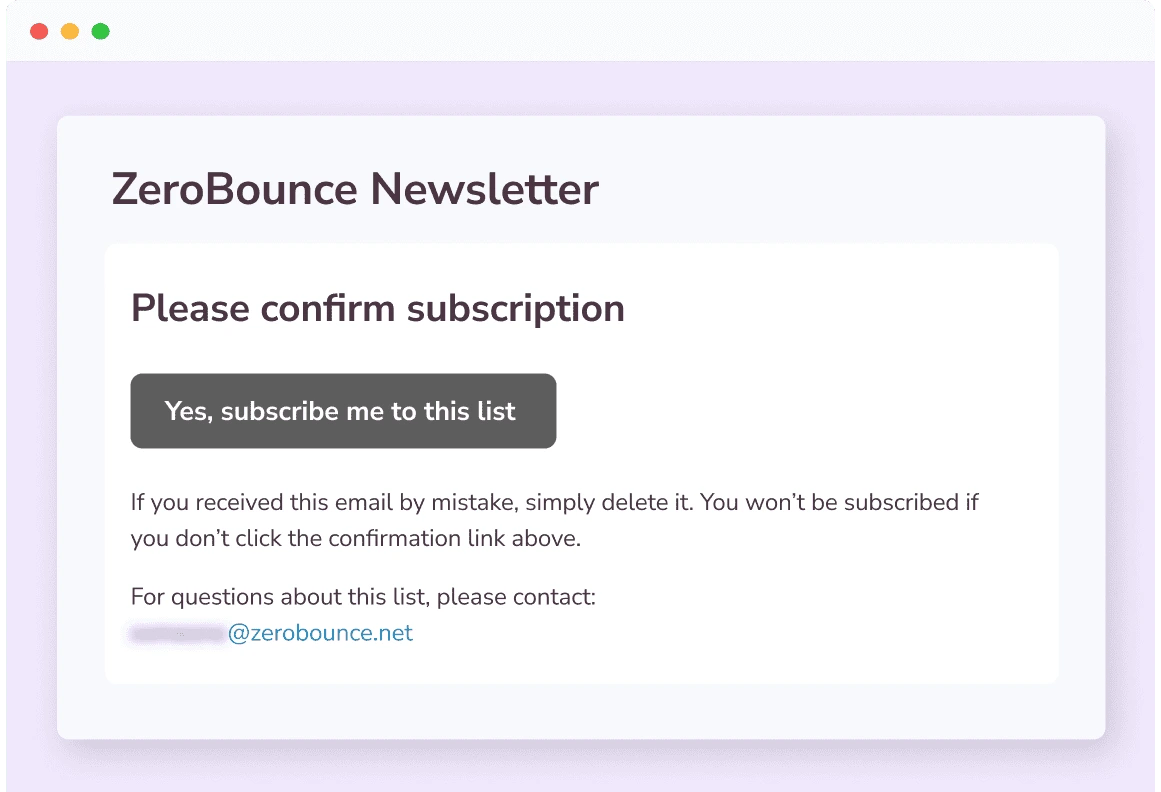
One of the easiest ways to boost email list health is to use double opt-in.
Send relevant, targeted content
Strive to keep subscribers engaged with the right content. If it doesn’t resonate with your audience, your email list health can be in jeopardy as people will stop engaging or start to mark you as spam.
Are you getting too many spam complaints? Here’s what you can do
No doubt you’re on board with the idea that email hygiene is something you can’t overlook. To land in the inbox and boost your conversions, you need to trust that you’re reaching out to real people with valid email addresses.
Next, let’s see how you can scrub your list in just a few steps!

Email list scrubbing is the first step to better email hygiene. checks 100,000 contacts in 45 minutes.
The one prerequisite is that you must . It pays to find an email scrubber that has a good reputation and offers a variety of tools to help your emails succeed.
With the right platform, the email scrubbing process is a breeze. Here are the steps:
Just make sure it’s a file type the email scrubber accepts. ZeroBounce, for instance, allows you to gather and upload all your email addresses in .txt, .xls, .xl,sx and .csv files.
The process shouldn’t take long. For example, ZeroBounce’s email cleaning software validates 100,000 email addresses in about 45 minutes.
That’s it! You get to see how many obsolete emails were hindering your inbox reach. No,w you can remove them and be confident that your sender reputation will see a boost.
Want to see the step-by-step? Watch this video tutorial:
As you can see, validating your email list is as easy as 1-2-3:
While it’s not a lengthy process, you can make it even faster by taking advantage of integrations. Good email scrubbing services integrate with popular platforms to allow you to check both your existing email list as well as incoming leads.
Let’s say you gather email addresses from social media – how do you ensure they’re accurate and real? Integrating your email checker into your lead-gathering platform gives you an extra layer of defense against poor-quality data.
For example, – such as Facebook, Google Sheets, WordPress/WooCommerce, Cloudflare or LinkedIn. Some of these integrations are native, including Mailchimp, Hubspot, Salesforce, Shopify, Constant Contact, and AWeber.
That means you can scrub your email list even faster by:
What if there is no integration for an application you’re using?
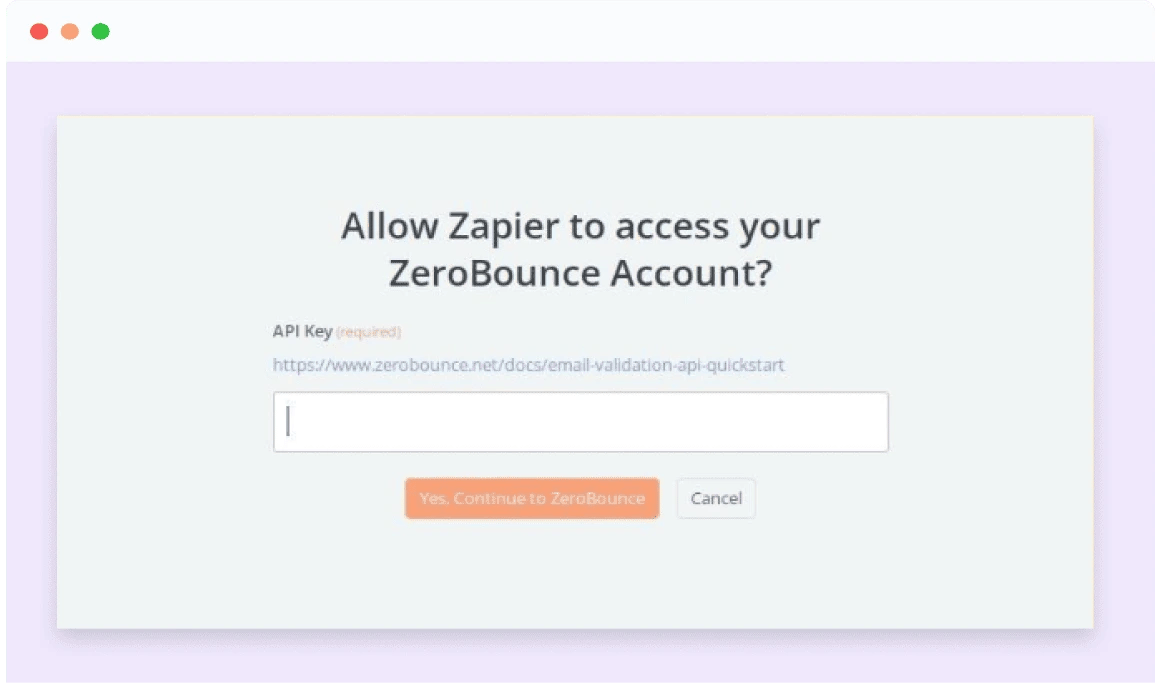
Zapier allows you to integrate with any program that we don’t currently offer an integration. It’s a great way to automate your workflows to make email hygiene instant and effortless.
Sign up for a free ZeroBounce account
Try it freeWhen you use an email validation service, you’ll find there are more than inactive emails that lurk on your list. Getting rid of inactive email addresses will , but you must be aware of the other potentially harmful contacts. Here are some of the common risky email addresses that will cause your emails to go to spam:
Abuse emails
Abuse emails are email addresses that belong to known complainers. Certain individuals will habitually even if they subscribed. Sometimes, they do it by mistake, but they can hit the “mark as spam” button if your email doesn’t have an unsubscribe link.
Of course, some known complainers have a malicious streak. To prevent them from tarnishing your sender reputation, an email verifier will help you identify and remove them.
Temporary emails
Temporary emails have a short life span, just as their name suggests. Sometimes called , these addresses are popular among people who want to avoid giving away their real contact information.
While valid when subscribing to your list, temporary emails can self-destruct in as little as 15 minutes but generally not longer than a day or two. For you, that only means a higher bounce rate once these emails vanish. High-quality email validators detect to help you avoid bounces and maintain email deliverability.
Catch-all emailsⓘ
Catch-all emailsⓘ are set up to accept all emails sent to a domain. In an effort to make sure an email doesn’t slip through the cracks, some companies configure their domains to accept all incoming messages. Even if the email address doesn’t exist or is misspelled, as long as the domain is correct, the message goes through.
The problem with is that, although the recipient may initially accept your email, there is a good chance nobody will open and read it. What’s more, after first accepting your message, a catch-all domain may reject it later. In the end, you have a hard bounce.
Related:
Email validation services like ZeroBounce can identify catch-all domains, but catch-all emails cannot be validated. However, you can handle catch-all emails safely by scoring them before sending a campaign. An can give you a grasp of their validity.
We’ve covered email validationⓘ, and you can’t have email hygiene without giving your list a regular scrub. However, it’s not the only line of defense you have to prevent data decay. Let’s explore how you can really step up your email hygiene.
Use an email validationⓘ API
An email validationⓘ API works just like a bulk email validator – only in real time. This piece of software checks every new sign-up instantly and blocks harmful data from making it to your list.
It’s wise to connect it to your and website registration forms.
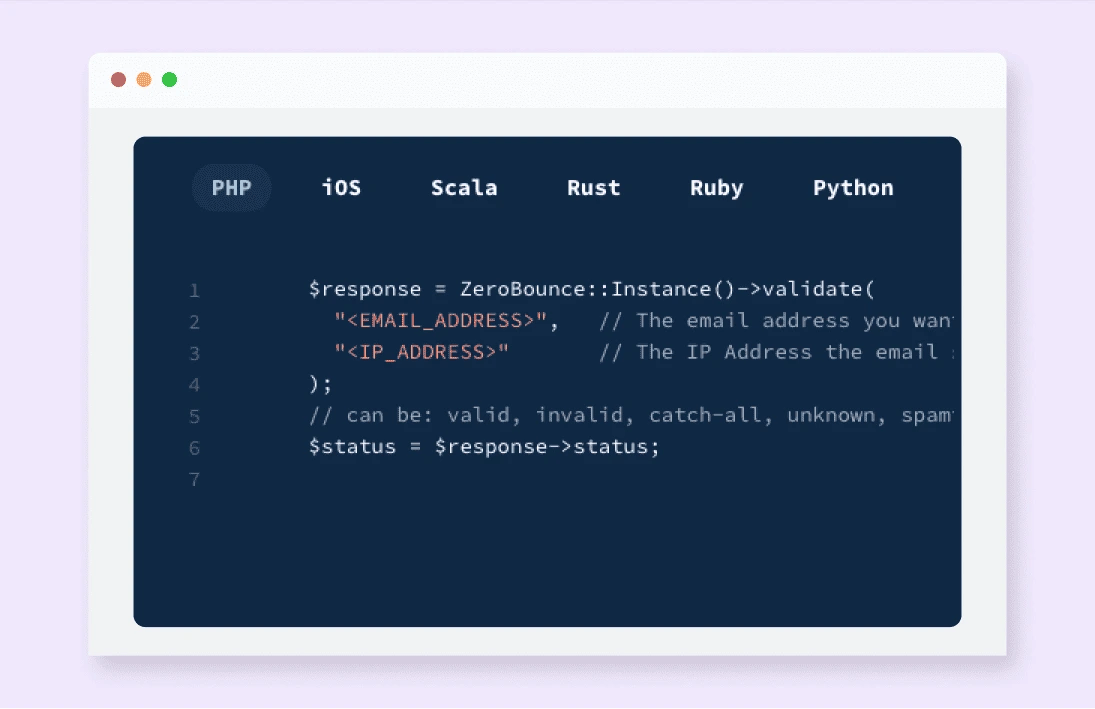
ZeroBounce provides both a real-time and bulk email validation API. The real-time API connects to your forms to check email addresses instantly. The bulk API allows you to .
Validate 100 emails for freeRemove unengaged subscribers
Some of your subscribers may have legitimate, working email addresses. They’re getting your emails but just don’t care enough to click on them, let alone read them. It may seem contrary to your goals, but it’s best to regularly weed out those lackluster, unengaged subscribers. Getting rid of inactive subscribers, even those with functional email addresses keeps your email hygiene high.
How to re-engage inactive subscribers
Let’s say one of your email subscribers was reading your emails, but suddenly, they just dropped off the face of the earth. Is it over? There may still be hope for keeping them on your list.
If you’re not ready to part with them, it’s time to initiate a . You’ll need to segment those inactive subscribers from your regular list and target them to see if you can win them back. This could be as simple as sending them an unbelievable exclusive deal. If it’s a deal they can’t resist, they may start being responsive to future pitches.
Now you have a better idea of how to . There are plenty of email marketing best practices that will help your email hygiene and boost your engagement and reach.
Here are a few crucial tactics:
Once your email list is clean, you can get back to focusing on high engagement levels.
Segmentation and personalization
Start by ensuring your emails are relevant and provide valuable information for your audience. For instance, call them by name in the subject or body of the email and customize the content based on their preferences, past behavior, and demographics. This is where the segmentation we performed earlier can really come in handy. Segmenting your email lists allows you to send more targeted, relevant messages to each audience.
Avoid spammy content
While we all like to sound clever, being clear and concise while creating curiosity can help encourage your audience to open and engage with your email. But be careful to like free, winner, act now, limited time, risk-free, urgent, cure, serious cash, and not spam.
Focus on design
Add high-quality, relevant images to make your emails more visually appealing. And use consistent branding, including colors, fonts, and logos, to . You also want to ensure your emails are readable. That is, make sure they’re mobile-friendly (using responsive design) with single-column layouts and nice fonts.
Emphasize the value
Whether it’s a short or long-form email, remember that each email provides value, such as informative content, interesting storytelling that creates emotional connections, exclusive offers, or useful tips. Compelling call-to-actions (CTAs) can then guide readers on what to do next.
Test new things
A/B testing allows you to regularly see which elements (e.g., subject lines, content, images, testimonials, and CTAs) of your emails resonate best with your audience. Don’t be afraid to experiment, as even small changes can make a significant impact.
Don’t Send Too Often
Finally, adjusting the frequency of your emails based on your subscribers’ preferences can encourage engagement. According to a survey by Marketing Sherpa, 49% of subscribers prefer to receive promotional emails from chosen brands once a week. But your audience may differ. Find out by testing emails or simply asking how often they want to receive emails from you.
Preventative maintenance does take time, but you can’t have email hygiene without it. The good news is that if you find a reputable email scrubbing service, you can frequently “set it and forget it.” It’s also worthwhile getting into a good habit before any problems creep in.
Following the actionable steps in this guide will keep your email list pristine. On the other hand, ignoring email health will cause problems. Feel free to review this guide from time to time. We’ll keep it updated with the latest developments in email scrubbing technology and deliverability tools.

From content marketing to PR projects, we count on Paul to write content that helps and inspires. Paul has a rich background in content creation as a writer, researcher and interviewer. For the past 20 years, he has conducted more than 1,000 interviews distributed via radio and podcasts. In his free time, Paul is always down for a long walk or a good movie, and loves trying out new restaurants.
Pro-tip: Remove unengaged subscribers regularly. That Yahoo or Gmail account that hasn’t opened one of your emails in ages may bounce on your next campaign.
A high bounce rate means lower email deliverabilityⓘ
Sending emails to invalid contacts is a surefire way to taint your sender reputation. A bounce rate higher than 2% sends a message to Internet Service Providers (ISPs) that you may be a spammer. As a result, ISPs will start directing your newsletters and campaigns to the spam folder.
You could be sending totally legitimate emails, but not removing inactive addresses will diminish your . It sends many email marketers down the road of trying to figure out how to remove bounced emails.
A clean email listⓘ protects your sender reputation
Your sender reputation, often measured on a scale from 0 to 100, plays a pivotal role in determining whether your emails land in the inbox or the spam folder. According to , a reputation below 80 is a clear sign of email hygiene issues, potentially leading to deliverability problems or even blocked emails.
Regularly scrubbing your email list removes risky contacts, lowers bounce rates, and demonstrates to ISPs that your emails are credible and targeted. A clean list ensures a higher sender scoreⓘ, leading to improved deliverability and better campaign outcomes.
Related:
Greater engagement rates and delivery
Having clean email lists directly impacts engagement rates. According to a study from HubSpot, regularly cleaned email lists can see open rates increase by up to 50%. High engagement rates are a strong signal to email service providers (ESPs) that your content is valuable. This helps and email deliverability.
Conversely, an email list that hasn’t been cleaned can lead to high bounce rates, which can negatively impact your sender score and cause emails to be filtered directly into , even by loyal subscribers.
In addition, when you scrub email lists to remove inactive subscribers, it allows you to focus your efforts on the people who are more likely to interact with your emails and your brand.
Better analytics
Clean email lists provide more reliable data on open rates, clickthrough rates (CTR), and other metrics, so you’re able to make more informed decisions about your email marketing strategy. For instance, you can better analyze the results of A/B testing.
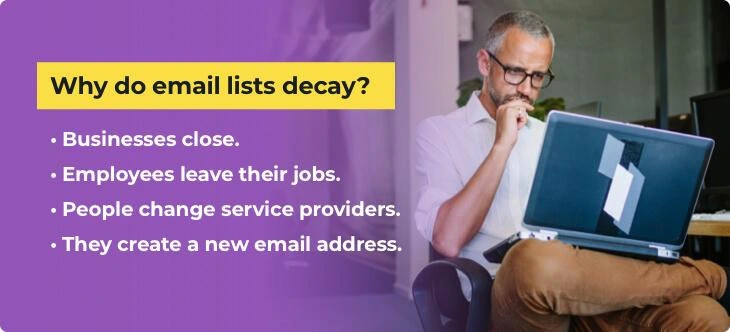
Financial benefits
By focusing your efforts on engaged subscribers, you’ll maximize your email ROI. Sending emails to invalid addresses wastes resources and increases costs. Most email marketing platforms charge based on the number of subscribers, so removing inactive or invalid emails can help reduce costs as you’ll only pay for engaged contracts.
Clean email lists also provide more accurate data, so you’ll know your audience’s preferences. This allows you to create with more accurate segmentation and personalization, which are key drivers of engagement and, ultimately, sales.
Regulatory compliance
Regularly cleaning your email list is also essential to stay in compliance with regulations like GDPR and CAN-SPAM. These laws require marketers to get explicit consent from recipients and provide clear opt-out mechanisms. Cleaning your email list ensures you’re only messaging those who have opted in to receive your content, which reduces the risk of penalties in addition to the benefits mentioned above.
Further, ensuring you shows respect for your audience and their preferences and privacy. This helps foster long-term trust and engagement.
Try re-engagement campaigns
If you aren’t ready to part with your unengaged subscribers, you can always try to get those subscribers back in the fold. Some email marketers find that the best tactic is to simply level with unengaged subscribers. It can work – you just acknowledge that they haven’t opened your emails, and that’s okay. It gives them an option to begin opening them, but if they don’t, you can remove them.
How active are your subscribers?Find out today
Keep an eye on deliverability
It pays to be proactive about the number of emails that land in your prospects’ inboxes. First, check your email marketing reports – how are your metrics? If you notice them dropping suddenly, it may be time for an email list cleaningⓘ.
This simple habit will go a long way in helping you maintain your email list and continue to enjoy good results from your email campaigns.
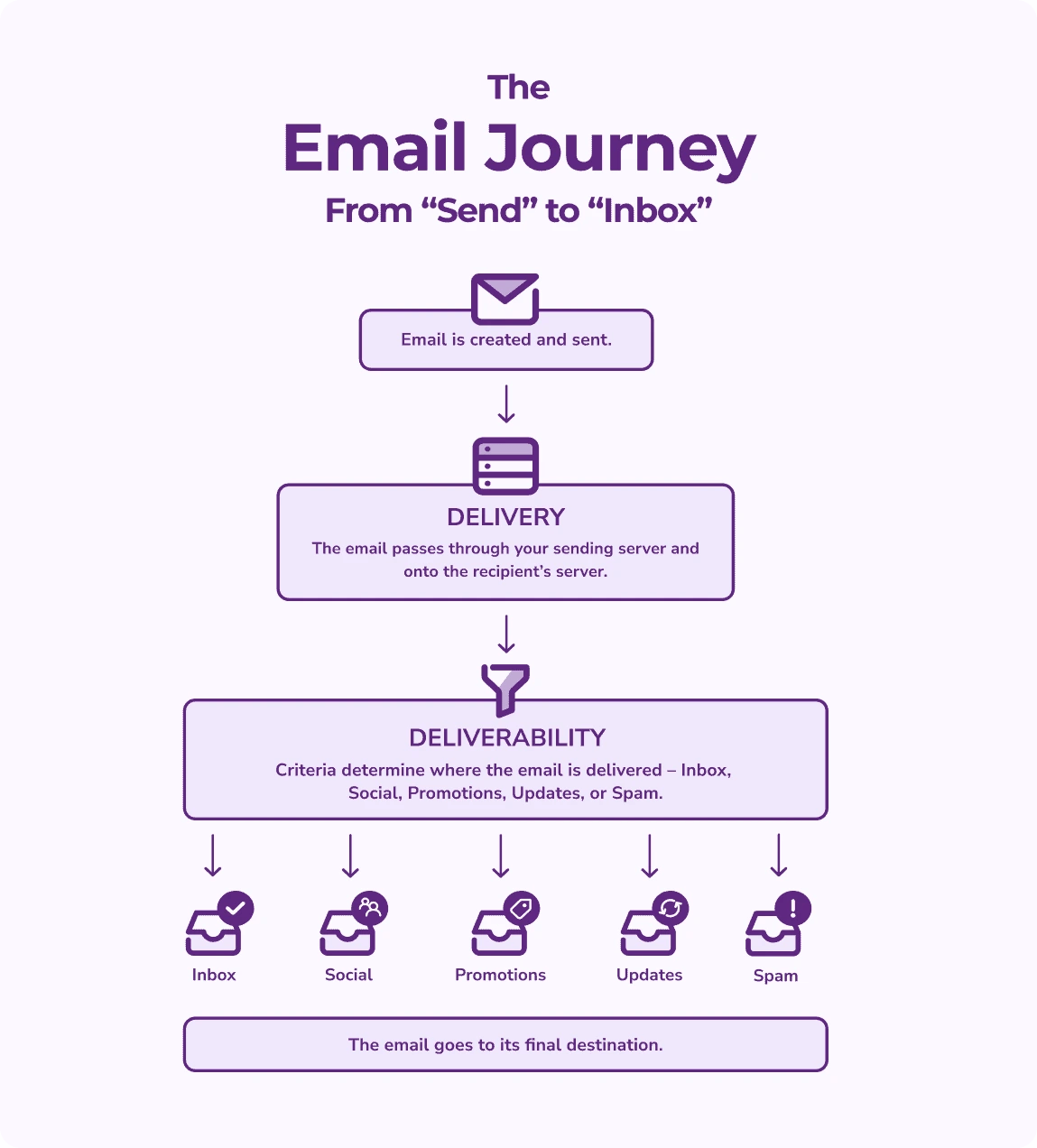
One of the best things you can do as an email marketer is to increase your .
Start a ZeroBounce account and validate 100 emails free – every month
Try it now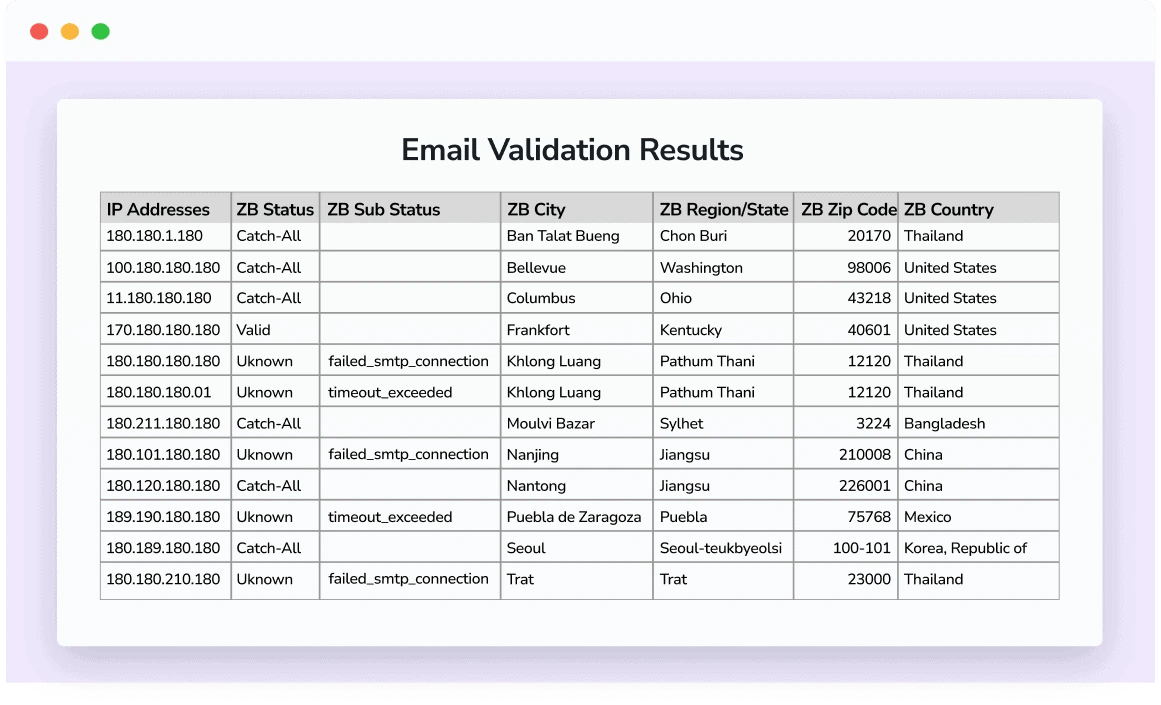
Here’s an example from ZeroBounce showing email validationⓘ results. As you can see, the software not only detects risky email addresses but also enhances your contacts with useful info such as geolocation.
Role-based emails
Many people check role-based email addresses, which have been around for ages. You’ve seen email addresses like info@, office@ or admin@. Generally, a team of people checks these email addresses as opposed to just one person. They tend to be unsuitable for marketing purposes.
Furthermore, with so many people checking role-based email inboxes, you’ve got a high likelihood that someone won’t know what your emails are – and therefore marks you as spam. Your email checker should help you easily identify any role-based email addresses so you can remove them. It’s best to err on the side of caution and discard them.
Spam traps
are emails designed to trap spammers. They are an extremely destructive type of email address.
Spam traps appear just as any normal email address would, and in some cases, they previously belonged to a person. However, they are no longer checked by any real person. Instead, Internet Service Providers (ISPs) and anti-spam organizations monitored them to combat spam. If your email hits a spam trap, it’s a huge blow to your sender reputation. Furthermore, your IP and domain may .
In an effort to keep spam volume down, ISPs and anti-spam groups regularly flag and block suspicious senders. Even though you send legitimate emails and have permission, you’re now in a precarious position.
Your email validationⓘ service should root out many of the spam traps in your database. If you’re on a blacklist, there’s a process to getting back to square one. A good email verification service removes duplicate emails.
De-duplication refers to the removal of duplicate data. Frequently email addresses will end up on a list twice or even more. This works to the advantage of some email platforms because they charge based on the number of contacts on a list.
However, it works to your disadvantage because your customers will get duplicate emails from you and may unsubscribe or, even worse, mark you as spam.
A good email verification offers a de-duplicator. ZeroBounce removes duplicate email addresses for free.
Test our ZeroBounce's free email verifier tool by entering an email below.
or